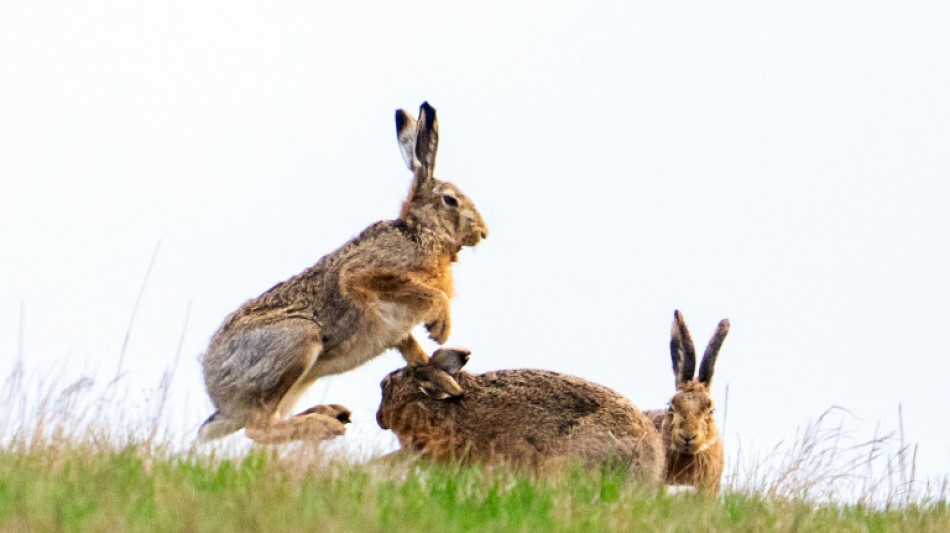
-
 Bolivia's new president takes over, inherits economic mess
Bolivia's new president takes over, inherits economic mess
-
Edwards set for Wolves job after Middlesbrough allow talks

-
 COP30: Indigenous peoples vital to humanity's future, Brazilian minister tells AFP
COP30: Indigenous peoples vital to humanity's future, Brazilian minister tells AFP
-
Marquez wins Portuguese MotoGP sprint race

-
 Saim, Abrar star in Pakistan's ODI series win over South Africa
Saim, Abrar star in Pakistan's ODI series win over South Africa
-
Norris extends title lead in Sao Paulo GP sprint after Piastri spin

-
 Man Utd have room to 'grow', says Amorim after Spurs setback
Man Utd have room to 'grow', says Amorim after Spurs setback
-
Tornado kills six, wrecks town in Brazil

-
 Norris wins Sao Paulo GP sprint, Piastri spins out
Norris wins Sao Paulo GP sprint, Piastri spins out
-
Ireland scramble to scrappy win over Japan

-
 De Ligt rescues draw for Man Utd after Tottenham turnaround
De Ligt rescues draw for Man Utd after Tottenham turnaround
-
Israel identifies latest hostage body, as families await five more

-
 England's Rai takes one-shot lead into Abu Dhabi final round
England's Rai takes one-shot lead into Abu Dhabi final round
-
Tornado kills five, injures more than 400 in Brazil

-
 UPS, FedEx ground MD-11 cargo planes after deadly crash
UPS, FedEx ground MD-11 cargo planes after deadly crash
-
Luis Enrique not rushing to recruit despite key PSG trio's absence

-
 Flick demands more Barca 'fight' amid injury crisis
Flick demands more Barca 'fight' amid injury crisis
-
Israel names latest hostage body, as families await five more

-
 Title-chasing Evans cuts gap on Ogier at Rally Japan
Title-chasing Evans cuts gap on Ogier at Rally Japan
-
Russian attack hits Ukraine energy infrastructure: Kyiv

-
 Kagiyama tunes up for Olympics with NHK Trophy win
Kagiyama tunes up for Olympics with NHK Trophy win
-
Indonesia probes student after nearly 100 hurt in school blasts

-
 UPS grounds its MD-11 cargo planes after deadly crash
UPS grounds its MD-11 cargo planes after deadly crash
-
Taliban govt says Pakistan ceasefire to hold, despite talks failing

-
 Trump says no US officials to attend G20 in South Africa
Trump says no US officials to attend G20 in South Africa
-
Philippines halts search for typhoon dead as huge new storm nears

-
 Bucks launch NBA Cup title defense with win over Bulls
Bucks launch NBA Cup title defense with win over Bulls
-
Chinese ship scouts deep-ocean floor in South Pacific

-
 Taiwan badminton star Tai Tzu-ying announces retirement
Taiwan badminton star Tai Tzu-ying announces retirement
-
New York City beat Charlotte 3-1 to advance in MLS Cup playoffs

-
 'Almost every day': Japan battles spike in bear attacks
'Almost every day': Japan battles spike in bear attacks
-
MLS Revolution name Mitrovic as new head coach

-
 Trump gives Hungary's Orban one-year Russia oil sanctions reprieve
Trump gives Hungary's Orban one-year Russia oil sanctions reprieve
-
Owners of collapsed Dominican nightclub formally charged

-
 US accuses Iran in plot to kill Israeli ambassador in Mexico
US accuses Iran in plot to kill Israeli ambassador in Mexico
-
New Zealand 'Once Were Warriors' director Tamahori dies

-
 Hungary's Orban wins Russian oil sanctions exemption from Trump
Hungary's Orban wins Russian oil sanctions exemption from Trump
-
More than 1,000 flights cut in US shutdown fallout

-
 Turkey issues genocide arrest warrant against Netanyahu
Turkey issues genocide arrest warrant against Netanyahu
-
Countries agree to end mercury tooth fillings by 2034

-
 Hamilton faces stewards after more frustration
Hamilton faces stewards after more frustration
-
World's tallest teen Rioux sets US college basketball mark

-
 Trump pardons three-time World Series champ Strawberry
Trump pardons three-time World Series champ Strawberry
-
Worries over AI spending, US government shutdown pressure stocks

-
 Verstappen suffers setback in push for fifth title
Verstappen suffers setback in push for fifth title
-
Earth cannot 'sustain' intensive fossil fuel use, Lula tells COP30

-
 Wales boss Tandy expects Rees-Zammit to make bench impact against the Pumas
Wales boss Tandy expects Rees-Zammit to make bench impact against the Pumas
-
James Watson, Nobel prize-winning DNA pioneer, dead at 97

-
 Medical all-clear after anti-Trump package opened at US base
Medical all-clear after anti-Trump package opened at US base
-
Sabalenka beats Anisimova in pulsating WTA Finals semi


Cute but calamitous: Australia labours under rabbit numbers
With their outsized ears and fluffy fur, rabbits are often seen as cute and harmless. Yet the creature is behind one of the globe's most harmful biological invasions, ravaging Australia, whose efforts to limit the problem have tended only to make things worse.
Back in 1859, a mere 24 European breeding rabbits, scientific name Oryctolagus cuniculus, disembarked from England, brought over by Thomas Austin, who enjoyed hunting parties on his Victoria estate.
But 150 years on, and according to a 2022 study by PNAS, a peer reviewed journal of the US National Academy of Sciences, some 200 million rabbit colonisers now roam the land of the kangaroo, devouring vegetation as they go, laying waste to native plant species, causing habitat degradation and threatening the survival of numerous native species.
With as many as seven annual litters -- each with an average of five offspring who reach sexual maturity from the age of 3-4 months -- the rabbit is able to spread its presence very quickly.
From its early years Down Under, the creature benefited from the general absence of predators and its facility to adapt to its new climate.
That enabled it to spread out by some 110 kilometres (65 miles) a year. Within 70 years, it had occupied around 70 percent of Australia's land mass.
That made it "the fastest known invasion by a mammal anywhere in the world," according to a report by Australia's national science agency CSIRO.
- Counting the cost -
The rabbit may look small and placid -- yet it is voracious in the extreme. Herbs, bulbs, seeds, shrubs -- its appetite extends to all kinds of herbaceous plant. This contributes to desertification of the outback, deprives other species of food and also eats away at crops.
The agricultural and horticultural damage wrought by the critters comes in at some 200 million Australian dollars ($130 million) each year, according to the Western Australian ministry for agriculture and food.
As such, for more than a century now, the authorities have been doing all they can to try to limit the damage.
Intensive hunting, traps, bulldozers to destroy burrows, poison or even explosives -- everything has been tried. But the rabbit has resisted and its numbers have progressed.
In 1901, Australia decided to construct an 1,800 kilometre-long (1,118 miles) barrier in a bid to stop the furry creatures proliferating to the country's western agricultural lands.
Yet by the time construction was completed, rabbits had already reached the other side. An extension followed, then another, taking the fence to beyond 3,000 km of barriers and fences. All in vain.
Australia tried plan B -- introducing predators, such as the fox.
The 'cure' proved to be worse than the disease. It turned out the fox preferred to target easier prey such as small marsupials endemic to the country and already threatened with extinction.
- Classic cases -
In the 1950, science was recruited to come to the rescue.
The myxomatosis virus, a disease which causes fatal tumours in rabbits, was introduced into the country. To begin with, success looked to have been achieved, the rabbit population going from 600 million down to 100 million. But it managed to adapt and ended up developing resistance to a virus which gradually became ineffective.
Australia tried a new angle of attack some years later: the Spanish flea, supposed to spread disease among rabbits.
Again, the plan failed. Worse still, the parasite infected other species.
In 1995, a new attempt at eradication followed, via a haemorrhagic fever virus, which ended up worrying the scientific community amid fears it might mutate.
Very effective against rabbits, this highly contagious pathogen can further spread quickly to other countries via mosquitoes. Two years later, it arrived in New Zealand, likewise also labouring under a rabbit invasion.
If Australia thought that might have been a price worth paying, there would soon be disabused.
The stoat, introduced as a predator to the rabbit left deprived as the population dropped, fell back on targeting the kiwi, a bird endemic to the island which became threatened in turn.
Both Australia and New Zealand represent classic cases in terms of what not to do regarding the introduction and management of invasive species, says Elaine Murphy, principal scientist at New Zealand's Department of Conservation and an expert on introduced mammals and the threats to diversity they pose.
While rabbit numbers look to have stabilised under the 300 million mark, the Australian government says it is maintaining research into means of permanently stemming the propagation problem.
A.AbuSaada--SF-PST



